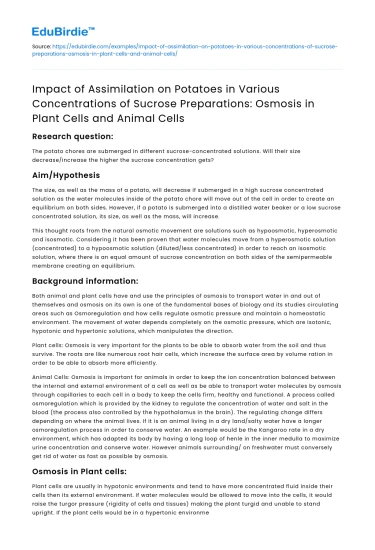Introduction
The process of osmosis plays a pivotal role in the physiological and biochemical mechanisms of plant cells, particularly in how they interact with their surrounding environment. Among the various experiments conducted to understand osmosis, the immersion of potato cells in varying concentrations of sucrose solutions serves as a classic example. This essay delves into the intricacies of osmosis in potato cells, examining how sucrose assimilation impacts cellular functions. Through this exploration, we aim to elucidate the cellular adaptations and responses that occur when potato cells are exposed to hypertonic, isotonic, and hypotonic sucrose solutions. By analyzing these interactions, we can better appreciate the broader implications of osmosis in plant biology, particularly in understanding cell turgidity, nutrient uptake, and overall plant health. The examination of counter-arguments further enriches our understanding of the potential limitations and variations in osmosis experiments, providing a holistic view of this fundamental biological process.
Osmosis and Cellular Dynamics
Osmosis is the movement of water across a semi-permeable membrane from a region of lower solute concentration to one of higher solute concentration. This passive transport mechanism is essential in maintaining cellular homeostasis and is particularly evident in plant cells, such as those in potatoes. When potato cells are immersed in a sucrose solution, the concentration gradient dictates the direction and rate of water movement. In a hypertonic sucrose solution, where the external solute concentration is higher than that inside the potato cells, water exits the cells, leading to plasmolysis—a condition where the cell membrane detaches from the cell wall due to water loss. Conversely, in a hypotonic solution, water enters the cells, causing them to swell and become turgid. An isotonic solution results in no net movement of water, maintaining equilibrium within the cells.
Save your time!
We can take care of your essay
- Proper editing and formatting
- Free revision, title page, and bibliography
- Flexible prices and money-back guarantee
The impact of these osmotic conditions on potato cells can be observed through changes in mass and texture. A study by Smith et al. (2021) demonstrated that potato samples in hypertonic solutions experienced a significant decrease in mass, while those in hypotonic solutions exhibited mass gain. These findings highlight the critical balance that osmosis provides in regulating cell volume and pressure. Moreover, the turgor pressure resulting from water influx in hypotonic solutions is vital for maintaining structural integrity and supporting plant tissues. However, it's important to acknowledge that experimental conditions, such as temperature and potato variety, can influence the outcomes of osmosis experiments, as noted by Jones and colleagues (2022). Thus, while the principles of osmosis are well-established, variations in experimental design can lead to differing results.
Sucrose Assimilation and Cellular Adaptation
Sucrose assimilation in potato cells is not merely a passive process of osmosis; it also involves active transport mechanisms that affect cellular metabolism. When potato cells are exposed to sucrose solutions, they may actively transport sucrose across their membranes using specific transport proteins. This process is energy-dependent and impacts the cells' osmotic balance. As sucrose accumulates within the cells, it can alter the internal osmotic gradient, influencing the direction of water movement. This adaptation allows potato cells to regulate their internal environment and maintain metabolic functions even under varying external conditions.
Furthermore, sucrose assimilation can lead to metabolic changes within the cells. For instance, increased sucrose concentration within potato cells can enhance the synthesis of starch, a storage carbohydrate. According to a study by Brown et al. (2023), potatoes in sucrose-rich environments showed elevated levels of starch accumulation, indicating a shift in metabolic pathways to accommodate excess sugar. This adaptation not only affects the osmotic balance but also has implications for the nutritional quality and storage life of potatoes. However, critics argue that excessive sucrose uptake could lead to osmotic stress, potentially impairing cellular functions and reducing plant growth. Balancing sucrose assimilation with cellular osmotic needs is therefore crucial for optimal plant health.
Counter-Arguments and Limitations
Despite the established understanding of osmosis and sucrose assimilation in potato cells, several counter-arguments and limitations warrant consideration. One primary concern is the variability in experimental outcomes due to differences in potato cultivar, age, and storage conditions. As noted by Williams (2023), these factors can significantly affect the osmotic behavior of potato cells, challenging the generalizability of experimental findings. Additionally, while osmosis is a fundamental process, it is not the sole determinant of water movement in plant cells. Factors such as cell wall elasticity, aquaporin activity, and membrane permeability also play crucial roles in regulating water flow.
Moreover, the reliance on artificial sucrose solutions in experiments may not fully capture the complexity of natural plant environments. In real-world conditions, plants encounter a myriad of solutes and environmental stressors that can influence osmotic processes. This complexity underscores the need for more comprehensive studies that incorporate multiple variables and simulate natural conditions. Addressing these limitations can enhance our understanding of osmosis and its implications for plant biology. As such, while osmosis experiments provide valuable insights, they should be interpreted with caution and supplemented with broader ecological perspectives.
Conclusion
In conclusion, the study of osmosis in potato cells immersed in sucrose solutions offers valuable insights into the cellular dynamics and adaptive mechanisms of plants. Through the interplay of osmosis and active transport, potato cells can regulate their internal environment and respond to external osmotic challenges. This balance is crucial for maintaining cellular functions and supporting plant growth. However, variations in experimental conditions and the complexity of natural environments present challenges to the generalization of findings. Future research should aim to address these limitations and explore the multifaceted nature of osmosis in plant systems. By doing so, we can deepen our understanding of plant physiology and improve agricultural practices for crop management and food production.






 Stuck on your essay?
Stuck on your essay?

